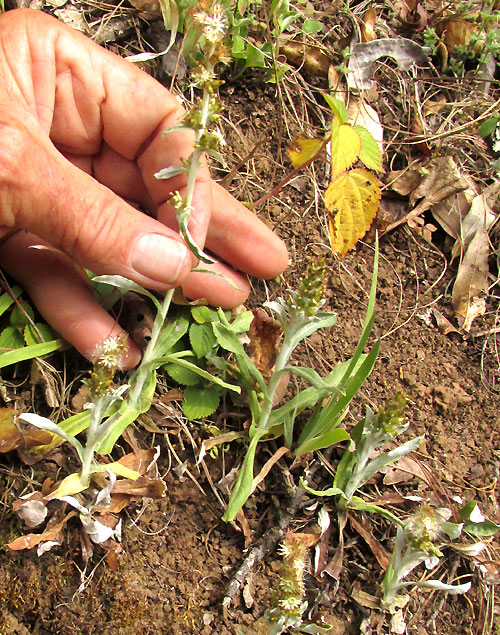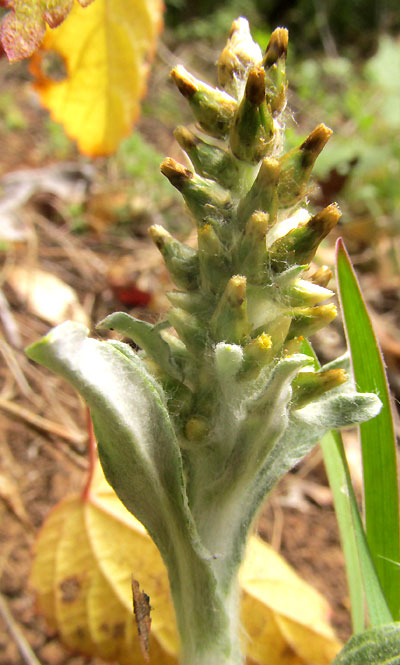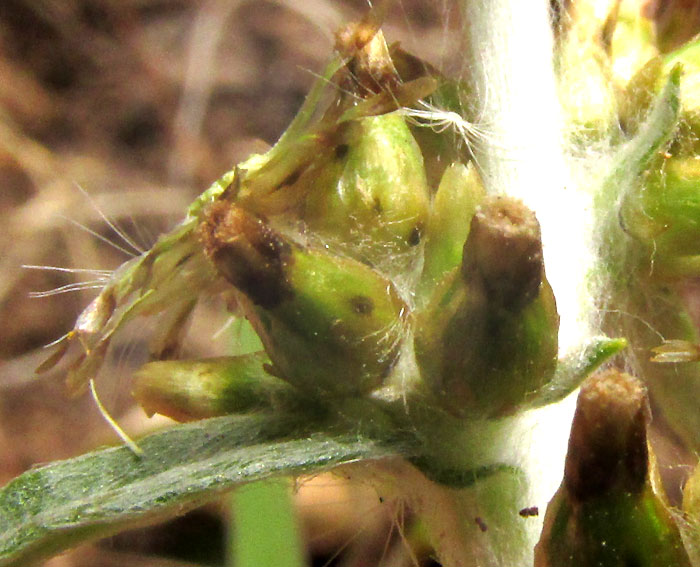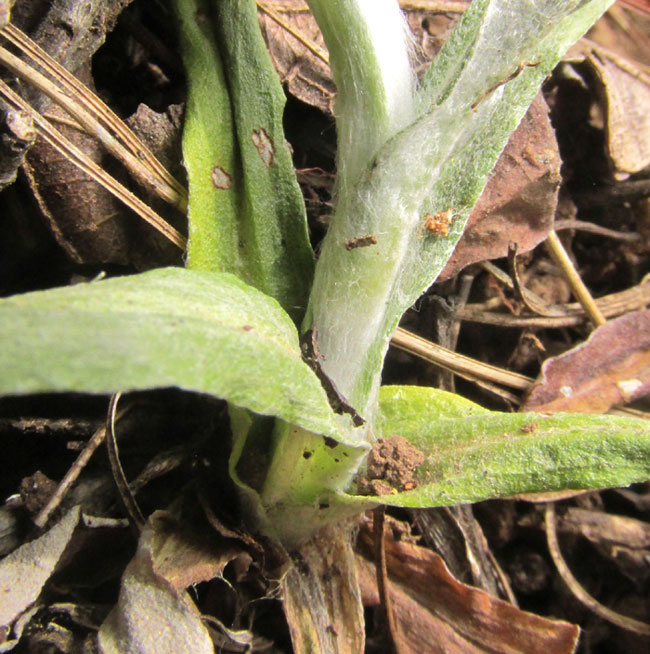Excerpts from Jim Conrad's
Naturalist Newsletter
entry from field notes dated January 19, 2023, taken along steep, one-lane gravel road ascending forested, northeast-facing mountain slope, elevation ±2,380m (7600 ft); bedrock of Cretaceous limestone; on the south side of Pinal de Amoles, Querétaro state, MÉXICO, (N21.134°, W99.629°)
PURPLE CUDWEED

On the eroded face of a roadcut into a slope forested mostly with pines, when I saw the above plants I knew it'd probably be hard to identify them, despite its being obvious which plant family they belong to. With individual flowering heads consisting of florets tightly packed within bowl-like involucres, they were members of the largest of all flowering plant families, the Aster or Composite Family, the Asteraceae.
The plants' general form and size, the flowering heads consisting of only cylindrical florets bearing no petal-like ray florets, and the stems and leaves being invested with dense, white, woolly hairs indicated that the plants were members of the Aster Family "tribe" Gnaphalieae, in the Americas best known for various species spread through different genera, known in English as cudweeds. Our roadcut plants were cudweeds. Cudweed genera often are defined by features which in the field are hard to see without a dissecting scope. With cudweeds, one really needs to "do the botany."

As seen above, this cudweed species' individual flowering heads were arranged atop the plants in spike-shaped arrays. The individual heads were egg-shaped and narrowed at their tops. Beneath each head arose a small, leaflike bract, and toward the array's bottom increasingly larger regular leaves became interspersed with the heads.

The above picture displays some very obscure features that are essential for identification to species level. Notice just above the cluster of heads the white item like an upside-down spider with many very slender legs. That's a cluster of hairlike bristles constituting a parachute-like pappus, which atop the plant's tiny, cypsela-type fruits catch in the wind and, under good conditions, carry the cypselae to new locations. All the various cudweed species bear pappi atop their cypsela, but only certain species have their pappus bristles united at their base, so that when they fall off they look like a spider, not individual loose hairs.
In the above picture, mmediately below the upside-down "spider," there's an immature head showing that the head's inner, green scales, or phyllaries, at their tips are somewhat broad but come to a sharp point; the scale's tip doesn't become slender and end with a hard point (apices acute, not apiculate). Finally, note that the tops of involucral scales on mature heads are dark brownish or purple.

The above image shows more essential identification features. First, an essential question to answer when identifying cudweeds is whether the leaves are markedly more woolly-white on one surface than the other. Especially on older plants where the upper surfaces that once were as white as the lower, but have weathered and become greener, the matter isn't always easy to decide. On this species, the leaves' upper surfaces are somewhat woolly-white, but the woolliness is sparser and the greenness shows through more on the upper surface, so I'm thinking these are "bicolored" leaves. Second, several species similar to our plant don't have leaves clustered rosette-like at their very bases when they flower, while other species do. Our plant appears to have had basal rosette-like leaves which with time withered and dried out, so that now they're brown and lying on the ground.
But, really, often it's hard to know what the experts' concept of having basal leaves is, as well as how "markedly bicolored" the leaves are.
All the above details and more -- such as studying species distribution maps -- bring me to GAMOCHAETA PURPUREA, known in English by various names, the most commonly occurring seeming to be Purple Cudweed. Apparently the "purple" in the name is derived from the involucres' dark brown-purple phyllary tips on mature heads. The fairly weedy Purple Cudweed occurs extensively throughout the Americas, except for the colder and drier parts, and the Amazon region of South America, plus it's become an invasive in many parts of the Old World.
This interesting observation about Gamochaeta purpurea is made by the Flora of North America: "In the flora area, some species have commonly been treated as variants within Gamochaeta purpurea; distinctions are evident in the field, where it is common to find as many as five species growing in proximity without intergradation." In other words, the genus Gamochaeta nowadays has been split into various species so similar to one another that earlier they were regarded just as normal variations of one species. That's why the above obscure details are necessary to notice.
In Mexico, the tendency is to call woolly-white, herbaceous plants, including our plant, what we call mullein, and still other species, by the name of gordolobo. The words lobo gordo mean "fat wolf." Numerous times in southern Mexico I have found people using our Gamochaeta-type gordolobos as cures for respiratory problems, including coughs.
Virginia Gabriela Cilia-López and others, in their 2021 publication "Ethnopharmacology of the Asteraceae family in Mexico," mentioned that Gamochaeta purpurea (they used the older name Gnaphalium purpureum) had been shown to demonstrate antibacterial and cytotoxic effects. Carlos Alcedo Mora, for his pharmacy degree, in 2018 produced a thesis entitled "Efecto cicatrizante del extracto hidroalcohólico de las hojas de Gamochaeta purpurea (L.) Cabrera “keto keto”, en ungüento aplicados en ratones Mus musculus Balb c." In this study, he wounded rats, then determined whether extracts of our plant helped in the healing process. They did, and he got the statistical data to prove it.